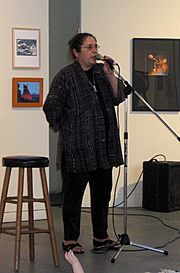Brulé facts for kids

Janeen Antoine (Sicangu Lakota), curator and educator
|
|
| Regions with significant populations | |
|---|---|
( |
|
| Languages | |
| Lakota, English | |
| Religion | |
| traditional tribal religion, Sun Dance, Native American Church, Christianity |
|
| Related ethnic groups | |
| other Lakota people |
The Brulé people are one of the seven main groups of the Teton Lakota, a large American Indian nation. In their own language, Lakota, they are called Sičháŋǧu Oyáte, which means "Burnt Thighs Nation." The French explorers heard this name and called them Brûlé, which also means "burnt." This name might have come from a time when they had to run through a grass fire on the plains.
Contents
Where the Brulé Live Today
Many Sicangu people live on the Rosebud Indian Reservation in southwestern South Dakota. They are part of the federally recognized Rosebud Sioux Tribe, also known as the Sicangu Oyate.
A smaller group lives on the Lower Brule Indian Reservation. This reservation is on the west side of the Missouri River in central South Dakota. Some Brulé also live on the Pine Ridge Indian Reservation, which is also in South Dakota. Each of these tribes is politically independent, meaning they govern themselves.
Understanding the Name "Sičhą́ǧu"
The word "Sičhą́ǧu" comes from the Lakota language. It means "burned thigh." This name connects to the story of how the Brulé people got their name, possibly from an event involving a grass fire.
Historic Brulé Groups and Families
The Brulé Lakota, along with the Oglala Lakota, are sometimes called the Southern Lakota. This is because they traditionally lived in the southern parts of the Lakota lands.
Historically, the Brulé were divided into three main regional groups:
- Lower Brulé: These people lived along the White River and near the Missouri River in South Dakota. They were sometimes called "Lowland People."
- Upper Brulé: These groups traveled further south and west onto the plains. They hunted buffalo along the Platte River in Nebraska. They were known as "Highland People" or "People away from the (Missouri) River." They often allied with the Southern Cheyenne and Southern Arapaho tribes.
- Brulé of the Platte River: This was a smaller group that split from the Upper Brulé. They lived even further south, generally along the South Platte River in Colorado. They also hunted near the Republican River.
The Brulé people were also organized into smaller, extended family groups called tiyošpaye. These groups would gather in family circles or camps, known as tiwahe. Some of these historic family groups included:
- Apewantanka
- Chokatowela
- Ihanktonwan
- Iyakoza
- Kanghi yuha
- Nakhpakhpa
- Pispiza wichasha
- Shawala
- Shiyolanka
- Wacheunpa
- Waleghaunwohan
Notable Brulé People
Many Sicangu (Brulé) individuals have become well-known for their contributions in various fields.
- Bob Barker: A famous game show host.
- Pappy Boyington: A brave Marine Corps fighter pilot during World War II.
- Mary Brave Bird: An author who wrote about her experiences.
- Leonard Crow Dog: A spiritual leader and activist for Native American rights.
- Paul Eagle Star: A performer who was part of Buffalo Bill's Wild West Show.
- Hollow Horn Bear: A respected chief.
- Iron Nation: A significant chief.
- Iron Shell: Another important chief.
- Little Thunder: A notable chief.
- Arnold Short Bull: A well-known holy man who helped bring the Ghost Dance to the Lakota in South Dakota.
- Lone Feather: The first Lakota person elected to the U.S. House of Representatives.
- Michael Spears: An actor.
- Eddie Spears: An actor.
- Spotted Tail: A famous 19th-century chief.
- Moses Stranger Horse: An artist.
- Two Strike: A chief.
- Albert White Hat: A teacher of the Lakota language.
- Dyani White Hawk: A contemporary painter and former art curator.
- Rosebud Yellow Robe: A folklorist, educator, and author.
- Frank Waln: A rapper.
Images for kids
-
.
The term "Sičhą́ǧu" appears on pages 3 to 14 of Beginning Lakhota.


